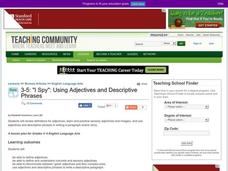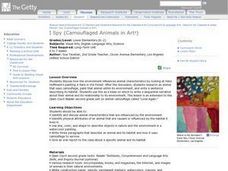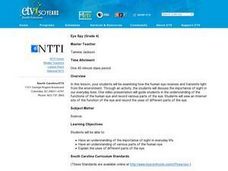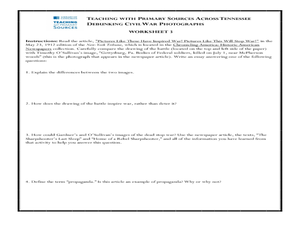Curated OER
I Spy Poetry
Explore the components of rhythm and form through a reading of Jean Marzollo's I Spy books. After discussing Marzollo’s format, the class agrees upon a theme for a class book and topics that fit with that theme. Pupils write a poem,...
Curated OER
I Spy Poetry
Students identify and interpret the rhythm and form of the I Spy poem.
They then integrate art, music, literature, technology, and writing with poetry. Students also write their own poem based on the picture they printed from the I Spy...
Curated OER
"I Spy": Using Adjectives and Descriptive Phrases
Students define adjectives and use adjectives and descriptive phrases to write a descriptive paragraph. They write a description of a sensory item, and read and discuss a five senses chart. Students then complete a chart using adjectives...
Curated OER
I Spy (Camouflaged Animals in Art!)
Make connections about animal characteristics and the animal's environment. For this animal characteristics lesson, students use a piece of art as a springboard for a discussion about animals and camouflage. Students choose an animal...
Curated OER
Ideas for Teaching Creative Poetry
Students read and write a variety of forms of poetry and create an original page for a class "I Spy" book. They read and discuss the form of poetry used in the "I Spy" books, and conduct Internet research on how the "I Spy" books are...
Curated OER
Eye Spy!
Students explore using descriptive words by playing a What Do You See? game, describing items in a Mystery Bag, and using Eye-Spy binoculars on an on-campus field trip. They read the book, I Went Walking, and write descriptions of a...
Curated OER
The Words that Surround Us
Students investigate writing that we read daily by analyzing advertisements and articles. In this language arts instructional activity, students discuss the images and writing they see daily, where it comes from, and what it represents....
Curated OER
Harriet The Spy
Fourth graders investigate the style of diary writing as its own genre of literature. They read Harriet The Spy in order to have a text for this literature study. Students use the skill of prediction to preview the story, and then...
Curated OER
Lesson H - I Spy
Students read and discuss a letter written by an Army officer from Delaware to the President of Delaware during the American Revolution. They examine paintings depicting the Battle of Bunker Hill and the attack upon the Chew House....
Curated OER
I Spy
Students examine a letter written by an Army officer from Delaware to the President (Governor) of Delaware during the American Revolution. Students compare the British and American Armies using Howard Pyle paintings.
Curated OER
Plain Polly: Adding Relevant Details
Students use a stick figure to help them learn to write with details. In this details lesson, students brainstorm details to add to the stick figure 'Plain Polly.' Students then draw stick figures for their own writing and give them a...
Curated OER
Poetry In Motion
Fourth graders read and analyze poetry and examine the process of writing poetry. They read and analyze the poem "From a Railway Carriage" by Robert Louis Stevenson, and answer comprehension questions. They identify the similes,...
Curated OER
Teaching with Primary Sources Across Tennessee: Debunking Civil War Photographs
Students analyze photographs and texts using primary source analysis. In this primary source lesson students determine whether the photographs and text are truthful.
Curated OER
Under the Sea - KWL Chart
Students create a KWL chart to start the discussion on ocean animals. They practice sorting the animals into their different classifications. They use indexes, table of contents and glossary to find information.















